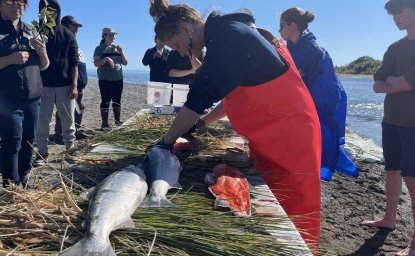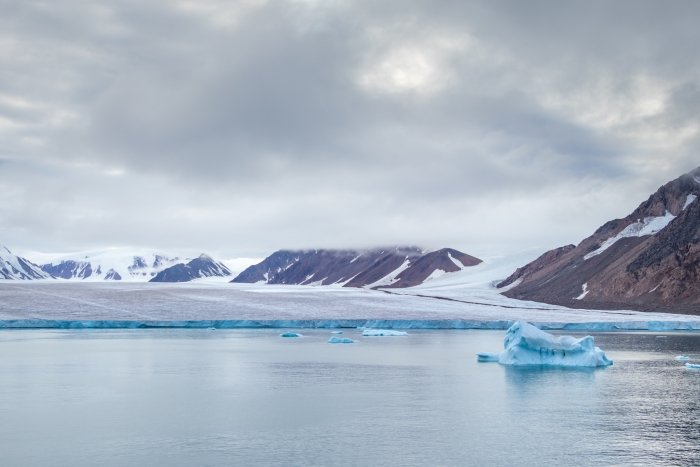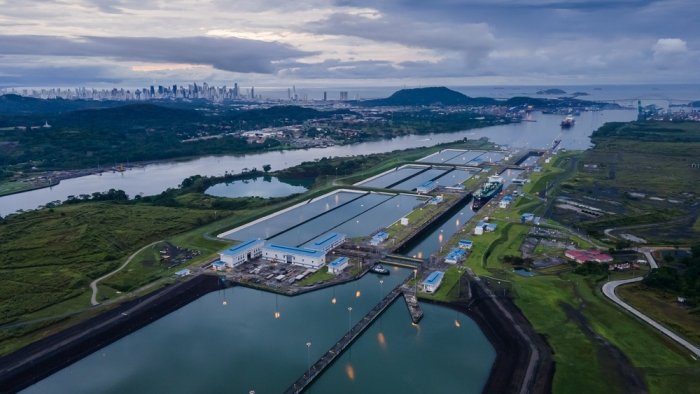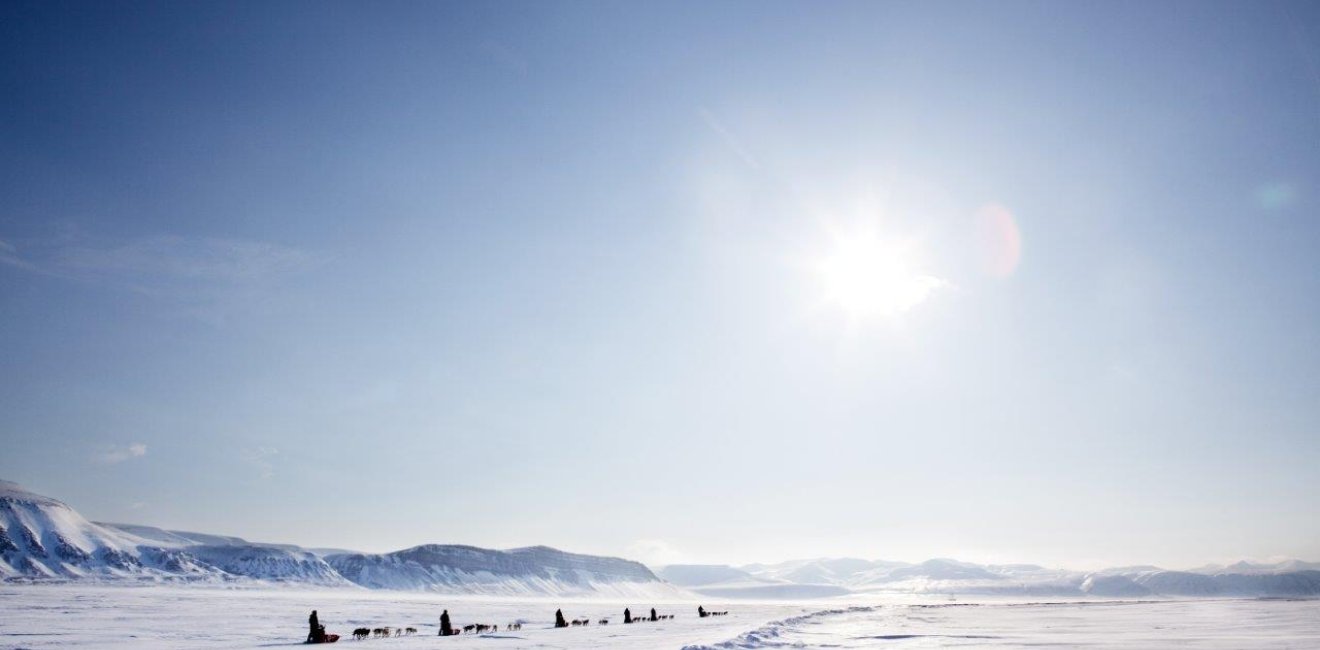Introduction
Although the United States is an Arctic Nation, most Americans have historically perceived the Arctic as both geographically remote and removed from issues affecting their day-to-day lives. In recent years, however, the Arctic has commanded greater attention – as a region with awe-inspiring landscapes, diverse Alaska Native communities, abundant wildlife and resources, a dramatically changing climate that affects global weather patterns, shipping lanes of growing importance, and more.
Profound changes in the Arctic have also raised awareness of serious challenges confronting the region and of the connections that our nation and the world have to developments in the Arctic. The Fifth National Climate Assessment (NCA5), released in November 2023, and NOAA’s 2024 Arctic Report Card reported that Alaska is warming at a rate at least two to three times the global average, with serious consequences for Arctic communities and ecosystems and growing impacts on lower latitudes as well.
The Arctic also faces worrisome challenges driven by rising geopolitical tensions. The Russian Federation’s unprovoked, full-scale invasion of Ukraine in 2022 has dramatically altered relations between Russia and other Arctic nations, severely limiting the ability to cooperate with Russia on Arctic matters. As half of the Arctic is within Russian territory, this severely constrains the ability to understand, through science and Indigenous Knowledge, how the Arctic is changing. China has also made clear its ambitions to play a greater role in the Arctic, while broadening its economic and security relationship with Russia, triggering additional concerns in the United States and other like-minded Arctic governments.
Building on significant progress made during the Obama Administration, the Biden-Harris Administration (BHA) brought considerable commitment to the Arctic to address the myriad Arctic issues and to confront the twin challenges of climate change and geopolitical tensions and their interrelationship. The BHA sought to continue to integrate policy and knowledge in service to the Arctic Region, to have sound science and Indigenous Knowledge inform and underpin policy decisions, and to have the policy needs of Arctic residents contribute to shaping scientific research pursuits. Among other accomplishments, the BHA:
- developed and issued two guiding documents to serve as roadmaps for this effort: the 2022 National Strategy for the Arctic Region (NSAR 2022) and the 2022-2026 Arctic Research Plan (ARP 2022-2026)
- reactivated the Arctic Executive Steering Committee to provide White House leadership in coordinating US Arctic policy across more than 15 Departments, Agencies, and Offices and to oversee implementation of NSAR 2022
- re-established the Northern Bering Sea Climate Resilience Area to address a range of concerns arising in those waters, including historically low returns of salmon to Alaska’s Arctic-Yukon-Kuskokwim (AYK) region
- created the position of Ambassador-At-Large for Arctic Affairs and appointed our nation’s first such Ambassador following Senate confirmation
- appointed the most diverse, inclusive, and Alaska-centric US Arctic Research Commission in history with highly qualified Commissioners,
- issued, through the US Arctic Research Commission, a Report on the Goals and Objectives for Arctic Research, 2023-2024, and
- brought, through the Interagency Arctic Research Policy Committee and the US Arctic Research Commission, a new focus on the real needs of Arctic residents in US research goals and plans.
In taking these actions, the Administration sought to align its overall national Arctic policy with Arctic science policy in pursuit of a long-term, comprehensive effort to promote the Nation’s interests in the Arctic region, to meet the most urgent needs of Arctic residents, and to advance understanding of this critical part of the planet for the benefit of present and future generations.
Here we present highlights of key accomplishments. Further details can be found in the National Strategy for the Arctic Region Implementation Report and the report on Arctic Research Plan Accomplishments 2022-2024.
Advancing US Arctic Policy
NSAR 2022 updated the 2013 National Strategy for the Arctic Region to take account of the new circumstances facing the Arctic and to incorporate new scientific understanding of the region. More than 15 Federal Departments and Agencies contributed to the policy, with input from the State of Alaska, Alaska Tribes and organizations, civil society, and Arctic Allies and partners.
While reaffirming long-standing US interests in and approaches to the Arctic, NSAR 2022 takes account of Russia’s full-scale invasion of Ukraine and associated consequences for the Arctic. NSAR 2022 also addresses the climate crisis with greater urgency, given the rapid pace of changes underway, and directs new investments in sustainable development to improve livelihoods for Arctic residents, while conserving the environment.
NSAR 2022 begins with a vision for the Arctic: “The United States seeks an Arctic region that is peaceful, stable, prosperous and cooperative.” That vision, also reflected in the 2022 National Security Strategy, remains the desired end-state, notwithstanding the challenges resulting from Russia’s war in Ukraine. In pursuit of this end-state, NSAR 2022 is organized around four mutually reinforcing pillars, spanning domestic and international issues: Security, Climate Change and Environmental Protection, Sustainable Economic Development, and International Cooperation and Governance.
The United States has made good progress in implementing NSAR 2022, as detailed in the implementation report noted above. Below are a few illustrative actions that advance the objectives in those four pillars, beginning with Pillar 1 (Security):
- Following Russia’s full-scale invasion of Ukraine, Finland and Sweden became NATO members, which enabled the United States to improve collective deterrence in the Arctic and enhanced its ability to respond to contingencies in the region. The United States strengthened readiness through increased training with Allies and partners. And it worked to reduce risks of conflict in the Arctic, to prevent unintended escalation or miscalculation, and to improve the security of the US Arctic homeland.
- The United States, Canada, and Finland signed a Memorandum of Understanding creating the Icebreaker Collaboration Effort in November 2024 to promote the production of polar icebreakers and other capabilities alongside US Allies and partners, labor, and industry.
- The United States collaborated bilaterally with Canada through various venues, including the binational North American Aerospace Defense Command, the Arctic Security Forces Roundtable, the Arctic Coast Guard Forum, and the Canada-United States Arctic Dialogue. The Arctic Dialogue was launched as part of the Roadmap for a Renewed US-Canada partnership established by President Biden and Prime Minister Trudeau in 2021.
To address the accelerating climate change challenge in the Arctic, and to deal with other environmental concerns (Pillar 2):
- The BHA took steps to slash greenhouse gas emissions in half by 2035 and achieve net zero emissions by 2050, advance adaptation and resilience in addition to mitigation, include nature-based solutions alongside technical approaches, pursue both land- and ocean-based approaches, recognize the need to remove carbon from the atmosphere and not just reduce emissions, measure greenhouse gas emissions in addition to estimating them, and provide useful climate data, products, and information to enable decision-makers from communities, businesses, and governments to make science-based, informed decisions. For example,
- Recognizing there is no path to net zero without the ocean, the Administration also produced the first Ocean Climate Action Plan and the associated National Marine Carbon Dioxide Removal Research Strategy.
- The Fifth National Climate Assessment (NCA5) detailed not only current and expected climate impacts to all regions of the United States, including Alaska, but also the bold climate actions underway in every state, including Alaska. The associated NCA Atlas makes downscaled climate data and projections readily available, thus vastly enhancing NCA5’s utility to Alaskans and those working with them.
- The National Climate Resilience Framework underscores the need for action to adapt to climate changes already underway and to enhance the resilience of communities, economies, and ecosystems; Federal Agency Climate Adaptation Plans and a review of resilience progress document the achievements to date.
- The federal government has made unprecedented technical assistance and resources available to support Community-Driven Relocation.
- The Inflation Reduction Act, the Bipartisan Infrastructure Law and the CHIPS and Science Act all provide urgently needed resources to implement the above-named strategies and commitments.
- US government agencies—heeding the above strategies, tapping the above-named resources, following extensive evaluation, and in consultation with rural Alaskan communities—made significant changes to their programs and funding opportunities to address the specific needs of Arctic communities. The changes have enabled communities facing multiple challenges to maintain viable economies while addressing a rapidly changing environment.
- Due in part to these changes, the US Government was able to provide significant assistance to rural Alaska Native communities that are facing confounding decisions on whether to relocate entirely, to engage in “managed retreat,” or to protect in place in response to extensive floods, erosion, and permafrost subsidence that is rapidly sloughing away land. Examples of this assistance include the following:
- The Department of the Interior (DOI) provided $21.8 million in 2022 and $30.4 million in 2023 to Alaskan Tribes and Tribal organizations under its Tribal Community Resilience Annual Awards program, primarily through funding appropriated pursuant to the BIL and the IRA. DOI also allocated $55 million in 2024 under this program, but as of this writing the fate of this funding is uncertain due to a freeze in the disbursement of federal funds mandated by the Trump Administration.
- USDA funded 17 watershed and flood prevention projects in Alaska that are focused on community-driven relocation, managed retreat, or protect-in-place.
- The Department of Housing and Urban Development (HUD) provided to the State of Alaska more than $38 million in Community Development Block Grant–Disaster Recovery/Mitigation funding. HUD also awarded the communities of Golovin and Newtok $900,000 each in Community Development Block Grant–Imminent Threat funding. In 2024, the community of Newtok largely completed its relocation to Mertarvik.
- Decisions on providing these types of assistance relied to a significant degree on a growing body of research concerning the environmental threats facing Alaskan communities.
- The United States also took steps to protect the Northern Bering Sea, which supports one of the largest marine migrations on Earth, critical fisheries, and seabird habitats, and is home to countless species of marine plants and animals. President Biden re-established the Northern Bering Sea Climate Resilience Area (NBSCRA) through an Executive Order that also created a federal task force to address challenges affecting these waters. The Executive Order also provided for the establishment of the Bering Intergovernmental Tribal Advisory Council (BITAC).
- In October 2024, the federal task force partnered with the BITAC to develop and sign a Joint Vision Statement to address the crisis resulting from historically low returns of salmon to the Norton Sound and the Yukon and Kuskokwim Rivers. The Yukon and Kuskokwim salmon runs are a foundational economic and cultural force for many Alaskan communities, and the declines have had wide-reaching consequences for Alaska. The Joint Vision Statement and DOI’s Gravel to Gravel Initiative represent significant steps toward the complex coordination needed to address the salmon crisis on the basis of science and Indigenous Knowledge.
To promote sustainable economic development in the Arctic (Pillar 3):
- The US Government allocated $7.6 billion in BIL funding for use in Alaska, with more than 1,863 specific projects identified for funding. Projects involved the transportation sector (e.g., funding for roads, bridges, public transit, ports, and airports), clean water and water infrastructure, and broadband expansion, among other things.
- The United States made considerable progress in extending broadband services throughout Alaska, including to rural areas, through programs administered by NTIA, USDA, and the FCC.
- The US Army Corps of Engineers, in partnership with the City of Nome, began designing modifications to the Port of Nome to provide larger vessels with improved access to Nome’s existing harbor by enlarging the outer basin and creating a new deep-water basin with a depth of 40 feet. Congress appropriated an initial $250 million for this project.
- In 2023, the US Geological Survey provided more than $5.8 million in funding to the Alaska Division of Geological and Geophysical Surveys to support airborne geophysical data collection and geologic mapping focused in regions with prospects for hosting critical mineral resources.
Finally, to advance international cooperation and governance (Pillar 4):
- In addition to swearing in Dr. Mike Sfraga as the United States’ first Ambassador-at-Large for the Arctic Region, the State Department enhanced US diplomatic presence in the Arctic by opening an American Presence Post in Tromsø, Norway, in 2023.
- The United States actively supported the Norwegian Chairship of the Arctic Council, contributing to a wide variety of sustainable development and environmental protection activities and to the advancement of joint scientific research.
- The United States played a leadership role in implementation of the Agreement to Prevent Unregulated High Seas Fisheries in the Central Arctic Ocean. The parties to this agreement adopted Rules of Procedure for the Scientific Coordinating Group and established a Joint Program of Scientific Research and Monitoring, including a data-sharing protocol. The parties also adopted an interim measure for exploratory fishing.
- In December 2023, the State Department announced the outer limits of the United States Extended Continental Shelf, which includes portions of the Arctic Ocean and the Bering Sea, thereby asserting US jurisdiction over significant areas of seafloor in these regions. The State Department also issued fact sheet with additional information about this historic announcement. The announcement followed two decades of the largest-ever offshore mapping effort by NOAA and USGS to collect data on the seabed and subsoil in many areas off the coasts of the United States, including in the Arctic.
- In September 2024, the United States and Canada announced the creation of a joint task force to undertake negotiations on the maritime boundary in the Beaufort Sea, including resolving the overlap in continental shelf in the Arctic Ocean. The task force, which began negotiations in November 2024, reflects the commitment of the United States and Canada to further define their shared northern boundary through cooperative bilateral negotiation and meaningful engagement with State, Territorial, and Indigenous partners.
Advancing Policy for US Arctic Science
The unusually dynamic and unpredictable nature of the Arctic region – due largely to a rapidly changing climate and other global changes – presents immediate needs and consequential opportunities for Arctic science. Arctic residents are striving to adapt to environments and ecosystems that are quickly evolving, leading to new economic impacts and amplifying uncertainty about the future. Understanding and addressing these complex challenges requires engagement from individuals and communities, local, state, regional, Tribal, and federal governments, and Indigenous organizations, as well as the support of people living in more temperate regions. Solutions require local and Indigenous Knowledge, contributions from policymakers, and the application of both social and natural sciences.
The Arctic Research Policy Act (ARPA), enacted in 1984, directs the Interagency Arctic Research Policy Committee (IARPC) to develop a national Arctic research policy and a five-year plan to implement that policy. The ARPA further directs IARPC to cooperate with the United States Arctic Research Commission (USARC) to establish “...a national Arctic research program plan to implement the Arctic research policy.” ARPA also gives USARC the responsibility to produce a biennial statement of goals and objectives for Arctic research to help guide IARPC in the development of the US Arctic Research Plan. The 2023-2024 Goals and Objectives report encourages further study of:
- Environmental Risks and Hazards
- Community Health and Well-Being
- Infrastructure, Impacts of Arctic Warming
- Arctic Economics
- Research Cooperation
In addition, the Goals and Objectives report directed attention to emerging topics in Arctic research, including Co-Production of Knowledge and use of advanced technology in Arctic research applications. Implementation of USARC directives has ensured that federal research activities address concerns of greatest urgency and have a high impact, and that future research investments target US national interests.
Policy drivers for the Arctic Research Plan have remained unchanged since 2012: to enhance the well-being of Arctic residents, to advance stewardship of the Arctic environment, to strengthen national and regional security, and to improve understanding of the Arctic as a component of planet Earth. Historically, these Plans were developed primarily by scientists and focused on their understanding of the state of knowledge of the region and scientific priorities for improving that understanding. Areas of inquiry often included, for example, studying sea ice, terrestrial and marine ecosystems, permafrost, and the atmosphere.
In contrast, development of the 2022-2026 research plan was much more inclusive and consultative, and it focused squarely on delivering useful knowledge to people of the region. Development of the report began by defining the most urgent knowledge needs to benefit Alaskan people. Through extensive consultation and engagement, the resulting Plan is more responsive to these needs, and more inclusive of Indigenous Knowledge, consistent with the Administration’s formal Guidance on Indigenous Knowledge. The Plan retains the “Arctic Systems Interactions” priority area but also prioritizes three other topics that are more directly related to the needs of Arctic communities: Community Resilience and Health, Sustainable Economies and Livelihoods, and Risk Management and Hazard Mitigation.
Supporting and infusing these priorities are five Foundational Areas: Education and Training; Data Management; Technology Innovation and Application; Monitoring, Observing, Modelling, & Prediction; and Participatory Research and Indigenous Leadership in Research. Under the 2022-2026 Plan, these Priority and Foundational areas now have the focused attention of researchers and federal agencies, and communities of research practice are forming. These interagency and cross-sectoral relationships will bear fruit well into the future, as new research questions are formulated and pursued.
Developed in coordination with the National Strategy for the Arctic Region, the Research Plan provides a framework for addressing complex problems from a comprehensive systems perspective to develop viable solutions while avoiding unintended consequences.
Because the Arctic is changing so rapidly, IARPC is implementing its five-year plan in two sequential two-year Implementation Plans; it recently released its Implementation Plan for 2025-2026, which has 85 deliverables focused on food security, resilient infrastructure, and human and ecosystem health, among other topics. IARPC is particularly focused on engaging Arctic communities and individuals in meaningful ways and on building agency capacity to better support Indigenous leadership in research.
Much has changed in the Arctic since 2021, when the current Arctic Research Plan was published. In 2025, IARPC will begin consideration of its next five-year plan, for 2027-2031, in consultation with the US Arctic Research Commission, the State of Alaska, and a broad range of Arctic communities, Alaska Indigenous groups, academic researchers, and others. The policy driver of regional, national, and international security looms large, as does the need to enhance the well-being of Arctic residents and develop community resilience in the face of accelerating changes to the earth system.
Other key cross-cutting research themes include monitoring, data sharing, and global linkages. The United States must join with other nations in strengthening and sustaining long-term Arctic observations and identify gaps and pursue integration with global observing systems.
There remains an urgent need for regional monitoring and measurement systems with innovations in data curation and management, working in partnership with Indigenous knowledge holders. Fortunately, the US Arctic research community has collaborated effectively with international Arctic scientists and engineers to develop a plan to ensure sustained observations and monitoring of essential environmental variables. Understanding the impacts of climate change on marine, coastal, and watershed ecosystems broadly and on specific species is essential for long-term food security.
Increased predictive capacity of emerging threats, including impacts of the changing hydrological cycle, permafrost thaw, and diminishing salmon and caribou populations, will enable more informed planning and development on local and national scales.
Technological insights on how to adapt infrastructure to changes, develop sustainable transportation, and support long-term investments in all forms of Arctic infrastructure are important for community sustainability and viability. The critical need for improved connectivity infrastructure throughout the Arctic is a constant refrain from rural communities, as is the need for reduced fuel costs and mitigation of toxic contamination that threatens water and soil. While community engagement has grown over the years, the United States government must build the capacity of local and Indigenous communities to participate in improving sustainable water, sanitation, and waste disposal management.
The concerns and needs of Arctic communities include many of these scientific priorities but extend to include issues of life, culture, and sustainability. Permeating all research priorities is the need for true co-production in research processes. Researchers should partner with Indigenous Peoples at the beginning of project development, focusing upon research questions driven by and created in partnership with communities, including through elevating Indigenous Knowledge and co-production. This includes specific research on how to bring together different knowledge and value systems. Arctic research must apply ethical approaches for scientific studies, and information sovereignty of Arctic Indigenous Knowledge should be a standard element of research design. The cross-cutting challenges of food security intersect with many northern community research themes. There is a need for increased research on food security and the impacts of climate change, development, and contaminants on the food chain, species, habitats, and subsistence activities. More specifically, Northern communities need baseline data, support studies, and impact assessments on subsistence species and long-term monitoring of species.
The year 2024 marked the 40th Anniversary of ARPA, the legislation that launched and directed much of the activity noted above. The anniversary provided a timely occasion to celebrate the enduring impact of this legislation, highlight progress across four decades, and look to the future of the region. Strong bipartisan support across the years for the common vision of science-based policy and action has delivered tangible benefits to the people of the region, the Nation, and the world.
Conclusion
The examples provided above highlight a few of the steps that the Biden-Harris Administration took to advance US interests in the Arctic with a view to realizing a vision of a peaceful, stable, prosperous, and cooperative region. Many of those examples also demonstrate the approach of integrating policy and science in pursuit of US interests in this critical part of the planet. Of course, much remains to be done to advance those interests in a changing world. Fully recognizing that each Administration will bring its own policy priorities to the table, it is also true that overall US objectives in the Arctic have generally remained stable over many decades, reflecting the enduring interests of our nation in this fascinating and important region.
- The authors wish to recognize the many contributions to the work described in this article during the Biden-Harris Administration by countless people throughout the federal government, and in particular to acknoweldge the efforts of their former colleagues in the White House Office of Science and Technology Policy, including Raychelle Daniel and Nancy Sung.
Authors




Polar Institute
Since its inception in 2017, the Polar Institute has become a premier forum for discussion and policy analysis of Arctic and Antarctic issues, and is known in Washington, DC and elsewhere as the Arctic Public Square. The Institute holistically studies the central policy issues facing these regions—with an emphasis on Arctic governance, climate change, economic development, scientific research, security, and Indigenous communities—and communicates trusted analysis to policymakers and other stakeholders. Read more

Explore More
Browse Insights & Analysis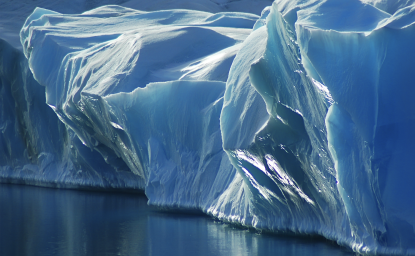
Facing Up to Climate Risk: Arctic Sea Ice, Tipping Points, and Possible Interventions
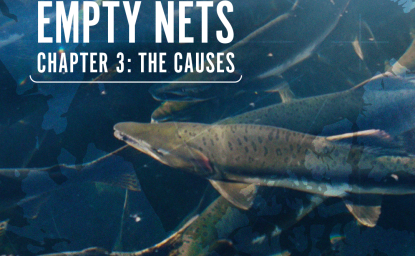
Empty Nets: Big Changes in a Great American Fishery | The Causes
